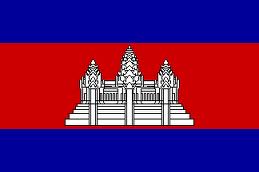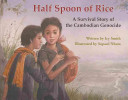by Yuri Wellington, Ph.D.; Executive Director, Teach Cambodia, Inc.; Professor and Director, Cambodia International Pedagogical Institute
 “Cambodian Children’s Literature.” That’s the topic of my series for January, but what does it mean, exactly? It could mean a number of things: Children’s books written and published in the USA and western world about Cambodia – or – Children’s books written by Cambodians – or – Books written and published for children in Cambodia… hmmm… We’ll come back to this later….
“Cambodian Children’s Literature.” That’s the topic of my series for January, but what does it mean, exactly? It could mean a number of things: Children’s books written and published in the USA and western world about Cambodia – or – Children’s books written by Cambodians – or – Books written and published for children in Cambodia… hmmm… We’ll come back to this later….
In March 2008 I was invited to travel to Siem Reap to conduct a number of workshops for teachers that would focus on literacy learning strategies for ELL students. In preparation for the trip, I gathered a large collection of books, big books, and hand’s-on activities to take as a donation. On the evening before the trip, as I performed a final review of the materials, I realized that many of the books were inappropriate (topics or situations not appropriate for the cultural setting) or simply irrelevant (depicting something that does not exist in the culture). What I finally ended up with was a stack of largely Eric Carle books, peppered with a few “classics” such as “Where the Wild Things Are” (Sendak 1963) and “Chicca Chicca Boom Boom.” (Martin, Archambault & Elhert, 1989). I later learned that books about nature or the environment, animals, or with animal characters seemed to comprise the bulk of what was found in most bookstores or school libraries in the country in 2008. In fact, one of the most popular publishers of books for children was an environmental protection NGO (non-governmental organizations – the global equivalent of a US nonprofit).
Cambodia – whose official moniker is “Kingdom of Cambodia: Nation Religion King” – is a country rich in history, culture, traditions and, most notably, scars from past atrocities. With a population that is 95% Theravada Buddhist and a governmental structure that mirrors many other post-communist, post-conflict restructuring scenarios, the topic of literature for children is a complicated one. Every organization registered to work in Cambodia must sign a contract stating that no information that conflicts with the government, religion, culture or traditions of Cambodia will be introduced. Thus, most of my favorite critical literacy/social issues/multicultural titles did not make the cut – not because they were not valuable, but because they were in direct violation of the agreement under which we were allowed to work in Cambodia.
 Let’s start our conversation with a title from the category “ Books written about Cambodia.” Today’s featured title is Half a Spoon of Rice (Smith, 2010). Set in the Khmer Rouge era (1975-1979), this story features a young boy who is forced out of his home, separated from his family and forced to labor in the rice fields. The tale describes his efforts to survive and his eventual reunion with his family. Typical of many books written about Cambodia, this story is based on true stories of Cambodian children during the Khmer Rouge era. Also like may books written about Cambodia, the story focuses upon the Khmer Rouge and post-Khmer Rouge era in Cambodian life. Illustrated by a Cambodian national now living in the USA, the images are incredibly realistic and authentic to Cambodian life, even today. This book is available in the WOW library and is in the WOW database. I highly recommend it for your classrooms, as a starting place to talk about Cambodia.
Let’s start our conversation with a title from the category “ Books written about Cambodia.” Today’s featured title is Half a Spoon of Rice (Smith, 2010). Set in the Khmer Rouge era (1975-1979), this story features a young boy who is forced out of his home, separated from his family and forced to labor in the rice fields. The tale describes his efforts to survive and his eventual reunion with his family. Typical of many books written about Cambodia, this story is based on true stories of Cambodian children during the Khmer Rouge era. Also like may books written about Cambodia, the story focuses upon the Khmer Rouge and post-Khmer Rouge era in Cambodian life. Illustrated by a Cambodian national now living in the USA, the images are incredibly realistic and authentic to Cambodian life, even today. This book is available in the WOW library and is in the WOW database. I highly recommend it for your classrooms, as a starting place to talk about Cambodia.
This title is especially appropriate for this time of year, as January 6 is “Victory Over Genocide Day” in Cambodia. It is an important national holiday, and all schools and businesses are closed. One of the central features of this commemoration are the slow, somber marches to the village Wat (temple), which draw hundreds and thousands in every village. A classroom activity might include discussion about war and genocide, and why it is important to remember these events. How is it helpful to those who experienced it? What about those who did not? A more general topic might be a conversation about loss, which is something everyone in every culture experiences during their lifetime.
BUT…. What critical literacy scholar worth her salt would not offer another perspective? Here are my (many) questions: What about the years following 1979? What about the rest of the story about Cambodia? What does it really mean for Cambodian children today, who live under the shadow of the genocide even though they don’t remember it and have not been taught about it? The issue that I struggle with as I attempt to find appropriate literature to embed in the Cambodian school curriculum and at the same time advocate for inclusion of Cambodia in the global curriculum of my USA colleagues is the narrow topic focus of books written about Cambodia. Almost universally, they focus on Khmer Rouge or post-Khmer Rouge stories. While that is important, that is not the only story to be told about a country whose culture and traditions date back over 8,000 years. It is also not the story of Cambodia today, which is as diverse as the story of people in the United States. You don’t have to go very far from the 4-story luxury hotels with scented air (yes, it’s true), air conditioning and spa bathtubs to find villages with no electricity or running water, where folks still live in 3-sided rooms built of bamboo. But even in those 3-sided rooms you will find a television, run on generator. It is true that half a spoon of rice may be all many children have to eat today in rural Cambodia. It is also true that a growing number of wealthy Cambodians drive around in Lexus SUV’s. You can shop at the traditional market with its many stalls, or you can go to the new multi-story supermarkets that are cropping up in many larger cities. Still an incredibly conservative culture, most women are well-covered, thus making many books that depict leg, shoulders or bathing suits inappropriate. But everyone has a cell phone, often two (one for work and one for home). And yet, even the most recent books published about Cambodia still focus on the genocide era.
Okay, so what else is there? Next week I’ll look at “Books by Cambodians.” I’ll introduce you to a Cambodian publishing company that publishes fiction and nonfiction books in Khmer, for Cambodian schools.
Meanwhile, please post your reaction to the book and to my comments. Soksabay! Yuri
References
Martin, B., Archambault, J. & Elhert, L. (1989). Chicca chicca boom boom. New York: Simon and Schuster.
Sendak, M. (1963.) Where the wild things are. New York: Harper Collins.
Smith, I. (2010). Half a spoon of rice. Manhattan Beach, CA: East West Discovery Press.
Websites
East West Discovery Press. http://eastwestdiscovery.com/
[Editor Note: Half Spoon of Rice is reviewed in Volume IV, Issue 2 of WOW Review.]
Journey through Worlds of Words during our open reading hours: Monday-Friday, 9 a.m. to 5 p.m. and Saturday, 9 a.m. to 1 p.m.
- Themes: Half Spoon of Rice, Icy Smith, Yuri Wellington
- Descriptors: Books & Resources, Debates & Trends, WOW Currents

Hello,
We are a bookstore from France specialized in selling books in foreign languages. I am interested in your articles about the editors in Cambodia or maybe some bilingual titles that were published in the United Stages.
A library asked us to find some Cambodian titles for children and I do know where to stard.
Many thanks in advance for you help!
Céline JAKUBEC
founder of Abrakadabra, specialized bookstore in France.
Cambodia
http://www.sipar.org/
http://www.monument-books.com/bookshop/
reyum publishing
U.S.
http://www.theantipodescollective.org/bilingual-books.html
Bloggers with list of books:
http://www.pragmaticmom.com/2016/11/books-for-kids-cambodia/
http://reads.samakiproject.org/